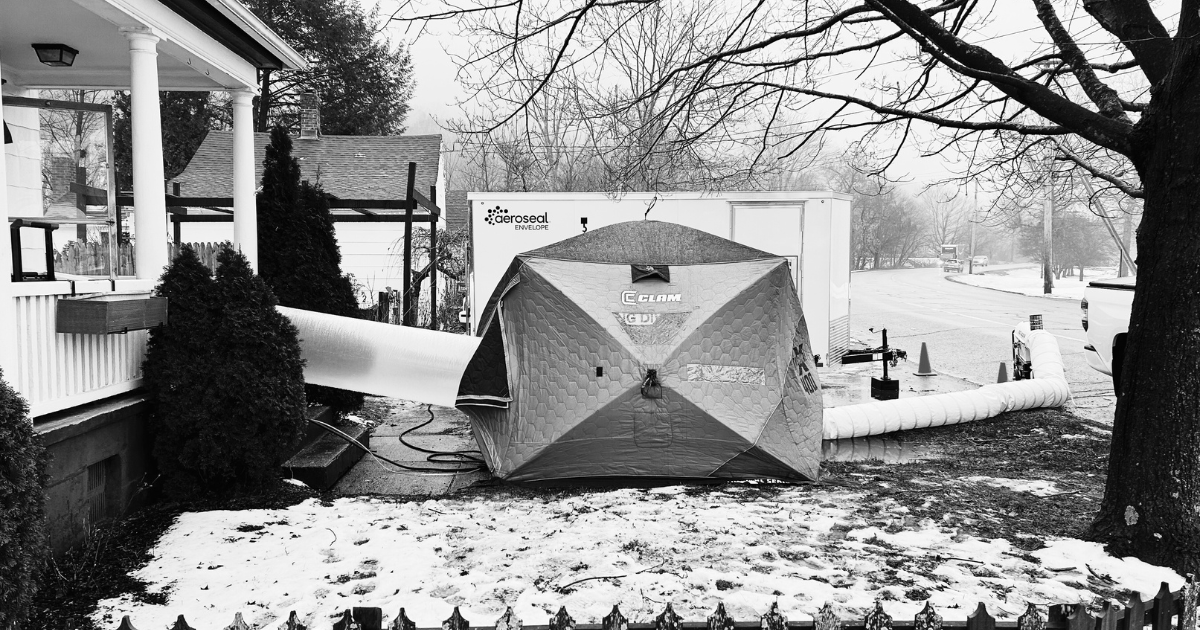Construction industry professionals face countless challenges throughout the Winter in Northern New England, a majority of which stem from the weather. Although Lord Building Solutions air seals from the inside-out, Winter weather impacts our processes, and has required us to develop a standard operating procedure for Winter installs.
One of our primary goals is to provide our air sealing services to our clients year-round in Maine and New Hampshire without increasing cost or install time. In order to do so, we have identified challenges that are specific to Winter installs, and implemented strategies and solutions that ensure a successful AeroBarrier seal.
Manual Air Sealing:
- Challenges – Spray foam and sealants can have issues curing when abutting a cold surface like an exterior wall.
- Strategies & Solutions – Prior to installing AeroBarrier, an LBS Technician inspects the building envelope/air control layer for gaps and cracks greater than a half-inch. All large voids are manually filled with spray foam or caulk. We ask our clients to preheat the structure for at least 24 hours before our arrival. This ensures surfaces in the building envelope have been warmed and are ready to receive sealant or foam. Generally, this is only a concern if we are sealing post rough-in.
Blower Door Fan Inlet Temperature:
- Challenges – The air pressurizing the building needs to be warmed. A 60-70 degree inlet temp will optimize the seal. An inlet temp below 50 degrees can create issues with the ejection nozzles.
- Strategies & Solutions – We utilize an insulated ice fishing tent to house the 4,500 CFM ruck fan and the systems Main Control Unit. A ducted, 110K BTU stovepipe heater blasts warm, dry air into the backside of the ice fishing tent. Even in temperatures below 30 degrees, we can maintain an inlet temperature at the fan that exceeds 60 degrees by using such a strategy. This ensures that warm air is pressurizing the building during the seal.
Technician Comfort:
- Challenges – During the seal, our technicians need to be situated close to the blower door fan assembly, also known as the injection point. Dexterity is required for 2-3 hours of computer operation.
- Strategies & Solutions – Our technicians are also housed inside the ice fishing tent, sitting comfortably at a fold out table while controlling the sealing equipment via the SmartSeal Software on the computer.
Heating System Shut Down:
- Challenges – The heating system or temporary heat needs to be shut off during the seal. This can lead to sequencing challenges as it pertains to protection measures and creates a sense of urgency once heat has been turned off.
- Strategies & Solutions – For a new construction or gut renovation project, we are installing post rough-in or post drywall/first coat of mud; therefore, breaking down the temp heating system is the last step before starting the seal. This involves masking the penetration in the building envelope that was used for the temp heating system. For a retrofit, the heating system is left on for as long as possible, and all active duct work is left unprotected until the last minute. That said, the final step of protecting the duct work is time sensitive. When protecting windows, finishes, etc., our technicians identify the locations of all duct work, and the materials needed (tape and/or foam blocks) to complete the protection in a timely manner.
Ventilating the Building After the Seal:
- Challenges – During the warmer months, we open windows and doors and leave the fan running to push the sealant out of the building. Cold temperatures and precipitation of any kind eliminate this option.
- Strategies & Solutions – Our technicians arrive to the jobsite equipped with two commercial grade air scrubbers. The scrubbers are placed and protected strategically in the building prior to starting the seal. Once the seal is completed, we leave the fan running and turn on the air scrubbers. This strategy clears the building of all atomized sealant in 30 minutes or less. Once cleared, the structure is safe for all to enter without a respirator.
Whether it be Northern New England’s exiting housing stock, gut renovations, or new construction, there is a demand for tighter building envelopes. As an industry, we need to reduce emissions from buildings, improve indoor air quality, and increase heating and cooling efficiencies. A tight building envelope is one of the best ways to meet or exceed these expectations.
AeroBarrier is less expensive and more effective than the typical, manual air sealing techniques that many builders are relying on today. Lord Building Solution’s Air Sealing Division operates year-round, maintaining a competitive price point and minimal disruption to a construction schedule by utilizing the Winter install strategies discussed above. Air Sealing with AeroBarrier will soon be the new normal, no matter the season!


